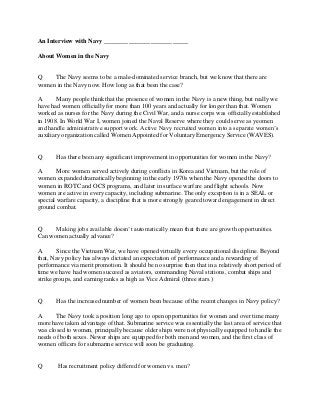
Women in navy
- 1. An Interview with Navy ___________________________ About Women in the Navy Q The Navy seems to be a male-dominated service branch, but we know that there are women in the Navy now. How long as that been the case? A Many people think that the presence of women in the Navy is a new thing, but really we have had women officially for more than 100 years and actually for longer than that. Women worked as nurses for the Navy during the Civil War, and a nurse corps was officially established in 1908. In World War I, women joined the Naval Reserve where they could serve as yeomen and handle administrative support work. Active Navy recruited women into a separate women’s auxiliary organization called Women Appointed for Voluntary Emergency Service (WAVES). Q Has there been any significant improvement in opportunities for women in the Navy? A More women served actively during conflicts in Korea and Vietnam, but the role of women expanded dramatically beginning in the early 1970s when the Navy opened the doors to women in ROTC and OCS programs, and later in surface warfare and flight schools. Now women are active in every capacity, including submarine. The only exception is in a SEAL or special warfare capacity, a discipline that is more strongly geared toward engagement in direct ground combat. Q Making jobs available doesn’t automatically mean that there are growth opportunities. Can women actually advance? A Since the Vietnam War, we have opened virtually every occupational discipline. Beyond that, Navy policy has always dictated an expectation of performance and a rewarding of performance via merit promotion. It should be no surprise then that in a relatively short period of time we have had women succeed as aviators, commanding Naval stations, combat ships and strike groups, and earning ranks as high as Vice Admiral (three stars.) Q Has the increased number of women been because of the recent changes in Navy policy? A The Navy took a position long ago to open opportunities for women and over time many more have taken advantage of that. Submarine service was essentially the last area of service that was closed to women, principally because older ships were not physically equipped to handle the needs of both sexes. Newer ships are equipped for both men and women, and the first class of women officers for submarine service will soon be graduating. Q Has recruitment policy differed for women vs. men?
- 2. A The Navy is an equal opportunity employer, so the recruitment policy remains the same for both sexes. The shift in recruiting policy has been a move to fit people to particular jobs rather than simply to fill positions. That process is based on capability, not gender. Q As time goes on, what do you expect to see regarding the number of women joining? A We want to see diversity in our ranks, and that includes gender and ethnic background as well as things like rural vs. urban upbringing. Essentially the goal is for the makeup of Navy personnel to be a reflection of America’s population at large. Although the type of work that we do and the lifestyle that requires might not be equally attractive to everyone, we certainly will work to introduce Navy to that broad audience and invite all to apply. Q You spoke earlier of lifestyle. Are there particular restrictions regarding things like grooming for women? A To be sure there are standards, just as there are standards for men. In general, the Navy expects responsible grooming, including hair that is not outrageously multicolored or faddish, cosmetics that enhance natural features, limited and tasteful jewelry, etc. More simply, personal grooming must not compete with the effect of the uniform. In any case, women in the Navy are nonetheless women. Q Would being a woman affect deployment? A In general, no. The only real departure from that is in the event of pregnancy. Servicewomen must not remain onboard a ship past their 20th week of pregnancy, and will not travel overseas beyond their 28th week of pregnancy. That policy clearly does not apply to men. Q Is training different for women than for men? A No, women undergo the same training as men and do it at the same time. It is important to note, however, that women do have separate living quarters. Q How do interested women find out more about their opportunities in the Navy? A Actually, the best first step is to contact the local recruiting station to find out about any and all of the jobs that we have available. To reach us, simply contact our station by calling ______________, or stop in most afternoons at __________________________________. If you or an out of-town friend want to locate another station near them, visit www.navy.com and
- 3. click on “find a recruiter” on the right side of the home page, then enter your zip code number. A call to 800-4go –Navy will do the trick as well. Additional comment: To put the Navy’s role in perspective, you need to recognize that 70 percent of the world is covered by ocean, 80 percent of the world’s population lives along coasts and 90 percent of the world’s commerce travels by water. Protecting all of that is our job, and that makes America’s Navy a global force for good. Sailors serve on land and from the sea; from ships on the water, submarines under the water, and planes and helicopters over the water – all to meet America’s threats far away so that those threats cannot harm us here. We welcome the best men and women to join us in accomplishing today’s missions and meeting tomorrow’s challenges. - 30 –
